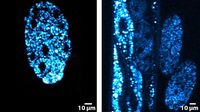Ultrafast Fiber Lasers for THG Microscopy
Best beam and pulse characteristics for THG microscopy applications
Third Harmonic Generation (THG) microscopy makes use of non-fluorescent samples by the combination of the advantages of label-free imaging with restriction of signal generation to the focal spot of the scanning laser in a multi-photon process.
THG is a process in which the energy of three incoming photons is combined to generate one outgoing photon with a wavelength of exactly one third of the excitation beam, if all the photons' energy is converted. One of the major benefits of this technique is that only a small fraction of the beams’ energy is stored in the specimen during the excitation and emission cycle.
Thus, to create a THG signal in the visible range above 400 nm wavelengths to prevent the signal from being absorbed by glass lenses, an excitation source emitting light at wavelength longer than 1200 nm is required.
TOPTICA's offer
In a life science laboratory, a suitable light source usually was an Optical Parametric Oscillator (OPO) pumped by a titanium-sapphire laser to reach such long wavelength at suitable pulse energies. TOPTICA now presents a broad variety of ultrafast fiber lasers as the perfect light source for THG microscopy. These laser systems combine the advantages of state of the art fiber laser, i.e. hands-off operation and extreme robustness with best beam and pulse characteristics. These characteristics are achieved by careful engineering and the long experience in design and fabrication of femtosecond modelocked fiber lasers at TOPTICA.

